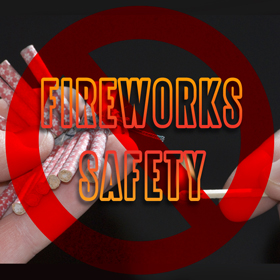Burning Truths about Holiday Safety

The Fourth of July holiday weekend is traditionally the time for parties, barbecues and fireworks, but for emergency rooms in New Mexico, it’s more than that.
It’s a day where the hospital staff knows to expect to see patients arriving suffering burns, bruises, lacerations, even foreign objects in the eye.
Fireworks are synonymous with our celebration of Independence Day, yet the day can also bring pain, even death.
The New Mexico Department of Health most recent available data shows on July 4, 2012, there were 23 emergency room visits for firework injuries in the state.
That same year, the US Consumer Product Safety Commission (CPSC) conducted a nationwide study of fireworks injuries from June 22nd through July 22nd. Here’s what they learned:
- On average, 200 Americans went to the emergency room for fireworks-related injuries every day.
- More than half of those injuries were burns.
- The most injured body parts were hands & fingers (41%); heads, faces and ears (19%); as well as chests (15%).
- Firecrackers are the most common source of trouble (23%) followed by sparklers & bottle rockets (each at 12%).
- It’s mostly boys and men getting hurt. Seventy-four percent of patients were male; mostly adults ages 25 to 44 and teens 15 to 19 years old.

There are things you can do to protect you and your family from fireworks injuries. The Department of Health and the CPSC recommend the following to assure a safe Independence Day this Friday:
- For starters: make sure fireworks are legal in your area before buying or using them.
- Never allow young children to play with or ignite fireworks.
- Always have an adult supervise fireworks activities. Too often we parents don’t realize the risk until too late. Sparklers, for example, burn at temperatures of about 2,000 degrees - hot enough to melt some metals.
- Make sure you, your kids, and others watch fireworks displays from a safe distance.
- Never place any part of your body directly over a fireworks device when lighting the fuse. Back up to a safe distance immediately after lighting fireworks.
- Keep a garden hose or water bucket handy in case of fire or other mishap.
- Never try to re-light or pick up a “dud” firework. If a firework doesn’t fully ignite the first time, chances are it won’t on the second attempt either, and you put yourself at risk should the firework explode in your hand.
- Light fireworks one at a time. The temptation is always there to try lighting more at a time for a bigger “pop” – but that only hurts the chances of the one with the match getting away in time.
For more information on fireworks safety, log onto the Consumer Product Safety Commission website.
Media Contact
We would be happy to provide additional information about this press release. Simply contact David Morgan at 575-528-5197 (Office) or 575-649-0754 (Mobile) with your questions.

